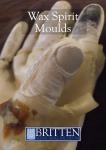
The Britten Memorial Museum, named after Emma Hardinge Britten, is housed in the Arthur Findlay College at Stansted Hall, Stansted Mountfitchet, Essex. The College is administered by the Spiritualists’ National Union, and the museum contains a wide range of exhibits relating to Spiritualism. Among these are a number of casts made from wax moulds, artefacts said to demonstrate the reality of spirits. The museum’s curator, Paul Gaunt (also editor of both the Psypioneer and The Pioneer electronic journals) has compiled this informative booklet which discusses the museum’s collection of casts, other instances of them in the literature, and the debate that took place within the Society for Psychical Research over the evidential value they provide.
The theory behind the moulds is that a spirit would be able to produce one by materialising a portion of itself, usually a hand but also part of a foot or even its face, and pushing it into a bowl of warm paraffin wax. The resulting wax sleeve could be set in cold water, leaving a mould that would be undamaged upon the limb’s dematerialisation. Repeated immersions, building up layers, would serve to increase the thickness and strength of the mould. As wax is so fragile, it can be filled with plaster of Paris which upon setting retains (leaving aside distortions and damage from handling) the shape and detail of the materialised body part in a more permanent form.
Wax moulds date from as early as the 1870s, but those at Stansted Hall were donated by Sutton-in-Ashfield Spiritualist church in Nottinghamshire, where they had been on display since 1938. These, Gaunt suggests, may well have been the last done by mediums (as opposed to researchers). An article in the 16 December issue of Two Worlds, which is reprinted, describes their production through the mediumship of William and George Finney, uncle and nephew, at Sutton-in-Ashfield.
According to the Two Worlds article, the moulds were created by the pair in informal conditions, not during a séance but sitting in the dark in a cupboard under the stairs with buckets of melted wax and cold water. The booklet contains three colour photographs of the museum’s casts, wax still adhering, showing them in all their strange beauty. One is of a pair of hands with interlinked fingers presented in a way that, it has been argued, would be more difficult to fake than it would a single hand.
The article is followed by an outline history of wax moulds, placing them in the context of the development of Spiritualist phenomena. Wax moulds were preceded by impressions left in putty and flour, but paraffin offered a more suitable material, and the technique was used by a number of mediums. Gaunt gives a short overview of some of them, but notes that each generally only tried the procedure for a brief period, and after becoming fashionable in the 1870s it went into abeyance until revived by the remarkable Franek Kluski, subject of a recent book by Zofia Weaver. Weaver and Gaunt both mention that at least in Kluski’s case it was a messy business, with splashes of wax everywhere, which perhaps made it unappealing for sitters even though the results were startling.
Gaunt includes sections on experiments with Kluski at the Institut Métapsychique International in Paris and in Warsaw conducted by Gustave Geley (three photographs, two of hands and one of a foot, from Geley’s 1927 Clairvoyance and Materialisation are shown, the hands revealing remarkable skin features), and on the rather fractious debate that took place in the pages of the Journal of the Society for Psychical Research in the early 1990s over whether it was possible to reproduce moulds like Kluski’s by normal means.
Gaunt’s conclusion from the debate is that a living hand can be removed from a wax mould IF the wax is of a reasonable thickness caused by repeated immersion; but the thinness that Kluski is reported to have achieved through a single immersion, and without setting in cold water, should make the operation impossible as the mould would be too fragile for withdrawal without its destruction. His verdict is that, pending further research which adheres to Geley’s precise method (which recreations so far have failed to do), Kluski’s moulds can be considered good evidence for the return of spirits.

